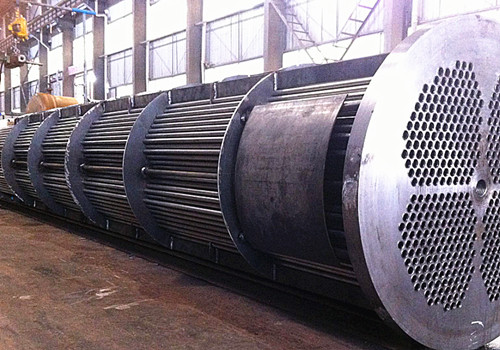Condensation is one of the pivotal parts of a turbine generator set. A condenser converts a gas or vapor into a liquid and quickly transfers heat out of the tube. Its performance directly affects the operation of the unit. Condenser works in a high-temperature environment which is essentially an exothermic process. As the main heat transfer component of the condenser, the cooling tube is the most important part of the condenser, the selection and selection of cooling pipe is the key to the design of the condenser. The commonly used material for condenser tubing are carbon steel, brass, cupronickel, titanium and stainless steel and so on, today here we will introduce the details of these materials.
Carbon steel tubing
The ASTM A179 Seamless steel tube is the primary material for tubular, heat exchanger, condensers, and other heat transfer services, especially for the shell well of tubular and box condenser. But the welding seam between the carbon steel tube plate and the tube is often corroded and leaked, which causes the operation collapse of the cooling water system and environmental pollution. The cooling water scaling is also a problem for carbon steel tubing in condenser system.
Brass tube
Cu-Zn alloy Brass tube used in heat exchanger has excellent heat transfer performance and good corrosion resistance. Compared with stainless steel tubes, it is not easy to scale. As long as the flow rate of water is increased, it is the preferred pipe material of the condenser. But it has great corrosion in the liquid with high salt content. How to maintain the normal operation of the brass tube condenser, prevent corrosion and how to make up after corrosion is very important. At present, many countries are studying an economical and durable alternative to brass, and white copper, titanium and stainless steel pipes have been put into use.
Cupronickel tubing
Cu-Ni cupronickel has better chemical stability than brass, and no selective corrosion tendency, its mechanism of corrosion resistance is to form a nanoscale surface film in air or water, which is compact, stable, high self-repair speed, to ensure the corrosion resistance of the pipe. So under the same working conditions, the corrosion of copper was significantly lighter than brass, has been mostly used in hard and when the water quality is not stable, but the price is higher than the brass, and because the REDOX potential of copper, nickel, easy to produce nickel corrosion and easy happening in the case of oxygen pitting, which limited the extensive application of white brass.
Titanium tube
As a new material of the cooling pipe, titanium has strong corrosion resistance to all kinds of water. Titanium condenser pipe shows significant resistance to general pitting corrosion, crevice corrosion and stress corrosion. It is considered to be the most corrosion-resistant structural metal, with small density and high strength, and the corrosion resistance in a boiling water environment is significantly higher than that of Cu-Ni alloy. However, titanium is not immune to corrosion. It is found that the main failure of titanium tubes is mechanical damage, followed by galvanic corrosion and scale formation when the titanium tubes are connected with dissimilar metal tube plates. Therefore, it is necessary to adopt all-titanium welding or cathodic protection to prevent galvanic corrosion. Due to the high price and installation cost of titanium tubes, they are only used in coastal and nuclear power stations.
Stainless steel pipe
The stainless steel tube has good mechanical properties, corrosion resistance and economy, and is the most potential trend of condenser tube. The condenser and jacket reactor is mostly made of Austenitic stainless steel (main types are AISI 304, 304L, 316, 316L). The overall heat transfer coefficient of stainless steel wave-welded pipe is increased by 25 ~ 30% than that of copper pipe. The actual operation data of several thermal power plants shows that the circulating water of stainless steel pipe is 20% less than that of the original copper pipe under the condition of maintaining the same vacuum degree. When the circulating water quantity is constant, the vacuum degree increases by more than 5%. The strength and surface hardness of stainless steel are higher than the copper pipe, high-speed steam, water droplets and sediment dirt and inlet jet will not cause erosion damage, is suitable for rivers and other sand dirt water, and high exhaust steam temperature of circulating water heating occasions. Stainless steel tube condenser has the following advantages.
- Thin-walled stainless steel welded pipes are much cheaper than copper and titanium pipes.
- High strength and hardness. The strength and surface hardness of the stainless steel tube is higher than the copper tube and titanium tube, its allowable stress is 1.6 times of the brass tube, 1.5 times of the titanium tube, so the high-speed steam and water droplets, or the sediment dirt and inlet turbulence can not form a significant erosion of the stainless steel tube.
- The elastic modulus is higher than that of copper tube and titanium tube. The vibration damping value is also larger than the copper pipe, the tensile strength is good, the linear expansion coefficient is lower than the ordinary copper pipe, which can reduce the stress from the internal.
- High corrosion resistance. In the air cooling area of the condenser, the metal surface of the heat exchange tube often accumulates some non-condensable gases, mainly ammonia and carbon dioxide, etc., and the copper tube is extremely sensitive to the corrosion of ammonia, resulting in ammonia corrosion. Stainless steel pipe just has a higher ammonia corrosion resistance than copper pipe, almost no corrosion, resistance to high-speed fluid and circulating water medium.
- More available materials. Increasing the content of Mo in stainless steel can effectively improve the crevice corrosion and pitting corrosion resistance of stainless steel tube in C1- containing medium, and increasing N element can not only improve the strength of stainless steel but also increase the pitting corrosion resistance and relative stability.







